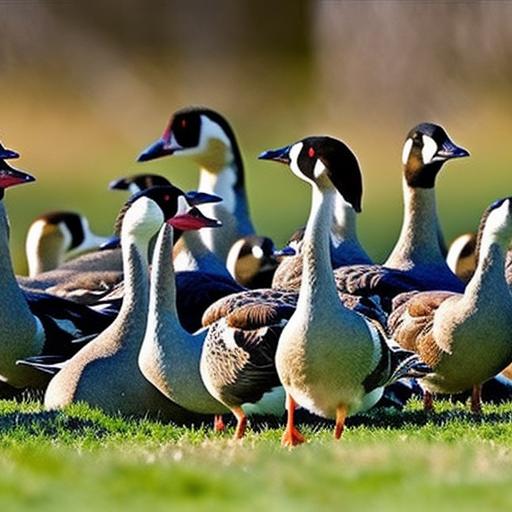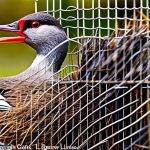Canadian geese are known for their strong migratory instincts and their tendency to return to the same nesting and feeding grounds year after year. They are highly social birds and often travel in large flocks, making them a common sight in many parts of Canada. Understanding their behavior is crucial in effectively managing their presence and preventing conflicts with humans.
One key aspect of Canadian geese behavior is their strong attachment to their nesting and feeding sites. They are known to be territorial and will aggressively defend their nesting areas from perceived threats. This territorial behavior can lead to conflicts with humans, especially in urban and suburban areas where geese may come into close contact with people. Additionally, Canadian geese are attracted to open grassy areas near water, making golf courses, parks, and residential lawns prime feeding grounds for these birds.
Another important aspect of Canadian geese behavior is their adaptability to human environments. They have learned to thrive in urban and suburban areas, taking advantage of the abundant food sources and open spaces. This adaptability has led to an increase in human-goose conflicts as geese become more comfortable in close proximity to people. Understanding these behavioral traits can help in developing effective strategies for managing Canadian geese populations and minimizing conflicts with humans.
Key Takeaways
- Canadian geese are territorial and protective of their nesting areas, so understanding their behavior is crucial in deterring them.
- Implementing physical barriers such as fences, netting, and hazing can effectively prevent Canadian geese from accessing certain areas.
- Visual deterrents like decoys, predator silhouettes, and reflective tape can help in deterring Canadian geese from settling in specific locations.
- Sound deterrents such as distress calls and loud noises can be used to discourage Canadian geese from staying in unwanted areas.
- Removing attractive food sources like grass clippings, garbage, and spilled birdseed can help in deterring Canadian geese from congregating in certain areas.
- Seeking professional help from wildlife management experts can provide effective and humane solutions for deterring Canadian geese.
- Respecting legal regulations regarding the treatment and management of Canadian geese is important to ensure compliance with wildlife protection laws.
Implementing Physical Barriers
One effective method for managing Canadian geese populations and preventing conflicts with humans is the implementation of physical barriers. These barriers can help deter geese from nesting and feeding in specific areas, reducing the likelihood of human-goose conflicts. One common physical barrier used to deter geese is the installation of fencing around sensitive areas such as golf courses, parks, and residential properties. The fencing should be at least three feet high and have a smooth surface to prevent geese from perching on it.
Another physical barrier that can be effective in deterring Canadian geese is the use of netting to cover water features such as ponds and lakes. This prevents geese from accessing the water and reduces their attraction to the area. Additionally, the installation of barriers such as hedges or shrubs can create a visual deterrent for geese, making it less appealing for them to nest or feed in specific areas.
It is important to note that physical barriers should be installed in a way that does not harm the geese or other wildlife. They should be designed to deter geese without causing them unnecessary harm. When implementing physical barriers, it is essential to consider the specific behavior and habits of Canadian geese to ensure that the barriers are effective in deterring them from nesting and feeding in specific areas.
Using Visual Deterrents
In addition to physical barriers, visual deterrents can also be effective in managing Canadian geese populations and preventing conflicts with humans. Visual deterrents work by creating an environment that is unappealing or threatening to geese, encouraging them to seek alternative nesting and feeding sites. One common visual deterrent used to deter Canadian geese is the installation of predator decoys such as plastic coyotes or owls. These decoys create the illusion of a potential threat to the geese, making them less likely to nest or feed in the area.
Another visual deterrent that can be effective in managing Canadian geese populations is the use of reflective objects such as Mylar tape or balloons. These objects create a visual disturbance that can deter geese from nesting or feeding in specific areas. Additionally, the use of scarecrows or other human-like figures can create a sense of danger for the geese, making them less likely to stay in the area.
It is important to note that visual deterrents should be used in conjunction with other management strategies for maximum effectiveness. Additionally, visual deterrents should be regularly moved or changed to prevent geese from becoming accustomed to them. By understanding the behavior of Canadian geese and implementing visual deterrents that capitalize on their natural instincts, it is possible to effectively manage their populations and prevent conflicts with humans.
Utilizing Sound Deterrents
Sound deterrents can also be an effective tool in managing Canadian geese populations and preventing conflicts with humans. These deterrents work by creating a sense of danger or discomfort for the geese, encouraging them to seek alternative nesting and feeding sites. One common sound deterrent used to deter Canadian geese is the use of propane cannons or bird distress calls. These sounds mimic natural predators or distress signals, creating a sense of danger for the geese and encouraging them to leave the area.
Another sound deterrent that can be effective in managing Canadian geese populations is the use of sonic devices that emit high-pitched noises or predator calls. These devices create a sense of discomfort for the geese, making it less appealing for them to nest or feed in specific areas. Additionally, the use of recorded sounds of natural predators such as coyotes or hawks can create a sense of danger for the geese, encouraging them to seek alternative nesting and feeding sites.
It is important to note that sound deterrents should be used in a responsible manner that minimizes disturbance to other wildlife and nearby residents. Additionally, sound deterrents should be used in conjunction with other management strategies for maximum effectiveness. By understanding the behavior of Canadian geese and utilizing sound deterrents that capitalize on their natural instincts, it is possible to effectively manage their populations and prevent conflicts with humans.
Removing Attractive Food Sources
One effective method for managing Canadian geese populations and preventing conflicts with humans is the removal of attractive food sources. Geese are attracted to open grassy areas near water where they can find abundant food sources such as grass, grains, and aquatic plants. By removing these food sources, it is possible to discourage geese from nesting and feeding in specific areas, reducing the likelihood of human-goose conflicts.
One common method for removing attractive food sources is the implementation of habitat modification techniques such as planting tall grasses or shrubs near water features. This creates a barrier that makes it less appealing for geese to access the water and feed on the surrounding vegetation. Additionally, the use of landscaping techniques such as mowing grass at longer heights can make it less attractive for geese to feed in specific areas.
Another method for removing attractive food sources is the implementation of wildlife management programs that focus on reducing the availability of food for geese. This can include the removal of invasive plant species that are attractive to geese, as well as the implementation of grazing programs that reduce the availability of grasses and grains. By removing attractive food sources, it is possible to effectively manage Canadian geese populations and prevent conflicts with humans.
Seeking Professional Help

In some cases, managing Canadian geese populations and preventing conflicts with humans may require the assistance of professional wildlife management experts. These experts have the knowledge and experience to develop effective management strategies that are tailored to specific environments and situations. By seeking professional help, it is possible to effectively manage Canadian geese populations while minimizing harm to the birds and other wildlife.
One common service offered by professional wildlife management experts is habitat modification, which focuses on creating environments that are less appealing for geese to nest and feed. This can include the installation of physical barriers, habitat restoration, and landscaping techniques that discourage geese from staying in specific areas. Additionally, professional wildlife management experts can provide guidance on implementing sound and visual deterrents that capitalize on the natural instincts of Canadian geese.
Another service offered by professional wildlife management experts is population control, which focuses on reducing the number of geese in specific areas through humane methods such as egg addling or relocation. These experts have the knowledge and experience to implement population control measures in a responsible manner that minimizes harm to the birds and other wildlife. By seeking professional help, it is possible to effectively manage Canadian geese populations and prevent conflicts with humans.
Respecting Legal Regulations
When implementing management strategies for Canadian geese, it is important to respect legal regulations that govern the treatment of wildlife. These regulations are designed to protect wildlife while minimizing conflicts with humans, and it is important to adhere to them when developing management plans for Canadian geese. By respecting legal regulations, it is possible to effectively manage Canadian geese populations while minimizing harm to the birds and other wildlife.
One common legal regulation that governs the treatment of Canadian geese is the Migratory Bird Treaty Act, which protects migratory birds such as Canadian geese from harm or harassment. It is important to adhere to this act when implementing management strategies for Canadian geese, ensuring that any deterrents or population control measures are implemented in a responsible manner that minimizes harm to the birds. Additionally, it is important to obtain any necessary permits or approvals from local wildlife authorities before implementing management strategies for Canadian geese.
Another legal regulation that governs the treatment of Canadian geese is local ordinances that may restrict certain management strategies such as hunting or trapping. It is important to research and understand these ordinances before implementing management strategies for Canadian geese, ensuring that any actions taken are in compliance with local regulations. By respecting legal regulations, it is possible to effectively manage Canadian geese populations while minimizing harm to the birds and other wildlife.
In conclusion, understanding Canadian geese behavior is crucial in developing effective management strategies that minimize conflicts with humans while protecting the birds and other wildlife. By implementing physical barriers, visual deterrents, sound deterrents, removing attractive food sources, seeking professional help, and respecting legal regulations, it is possible to effectively manage Canadian geese populations in a responsible manner. By taking a comprehensive approach that considers the behavior and habits of Canadian geese, it is possible to create environments that are less appealing for them to nest and feed while minimizing harm to the birds and other wildlife.
If you’re looking for ways to keep Canadian geese out of your yard, you may also be interested in learning about the best coop size for chickens. Understanding the space requirements for your chickens is essential for their well-being and productivity. Check out this informative article on how big a coop needs to be for a chicken to ensure that your feathered friends have the right amount of space to thrive.
Meet Walter, the feathered-friend fanatic of Florida! Nestled in the sunshine state, Walter struts through life with his feathered companions, clucking his way to happiness. With a coop that’s fancier than a five-star hotel, he’s the Don Juan of the chicken world. When he’s not teaching his hens to do the cha-cha, you’ll find him in a heated debate with his prized rooster, Sir Clucks-a-Lot. Walter’s poultry passion is no yolk; he’s the sunny-side-up guy you never knew you needed in your flock of friends!







